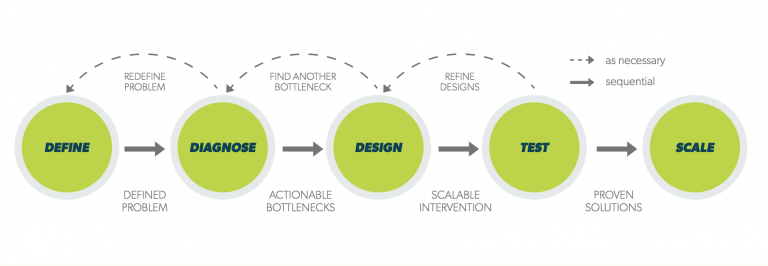Interview with: Erin Sherman
Erin Sherman is a Vice President at ideas42, a non-profit design and consulting firm that uses insights from the behavioral sciences to address complex social problems.

25 November 2019
Interviewed by Tali Arkushin and Ayse Lisa Allison
Can you tell us about your background and how you came to work in behaviour change?
I have an undergraduate degree in psychology. I developed an interest in policy and the environment, specifically around climate change. My thesis project centered around using psychological mechanisms to tailor energy saving messages. It was an interesting experience and helped me understand that work in this area was necessary and valuable. Right out of undergraduate study, I was fortunate to work at Opower (a software company that has since been acquired by Oracle). I worked on behaviour change which helped me understand the constraints and opportunities of giant field experiments. Right after Opower I joined Ideas42.
Can you tell us about the professional makeup of the team and how you work collaboratively together?
The biggest role division in our line of work is not between different backgrounds internally but between our internal team and our partners. Our partners are experts in various social areas, and we are in a position to ask them to suspend their conclusions – they are working on a variety of projects and have clear ideas about what good solutions will look like. Once they have identified the problem they tend to jump right to the solution, so we ask them to slow down. I find that moment challenging to navigate and important to navigate well.
Overall, we could not and would not do this work without the collaboration of experts in these fields. We accumulate some expertise in different areas but it is quite different from the expertise that a policy team would have about the needs of their constituents, so we try to incorporate and codesign with our partners. At Ideas42 we also have very diverse backgrounds. I am in the minority in having a psychology degree – many team members have a background in economics, public health, policy and other areas. For people not familiar with psychology and behavioural economics we have a curriculum, sowe have a common language to draw upon.
How is Ideas42 working to bring about sustainable behaviour change?
I like to think we do this in many ways. There are ways in which we look for the work that we will do: talking to partners, developing relationships and understanding where there is an opportunity for behavioural design. We think of that as a strategy question and it does involve some research.
Once we have a project, we examine how we will pursue it and hopefully get to an intervention. To decide what we are going to work on, we start with the Drawdown project, which is an ongoing research project that aims to depict what activities would need to be done to draw the carbon stock down to preindustrial levels. It’s not about emissions but stocks, ranking to the areas where the most carbon can be drawn down, so it helpful as a prioritization tool. For example, in the realm of food waste, partners are very interested in composting, but the more powerful carbon mitigation tool is preventing food waste from happening in the first place. That might contribute to our decision around how to pursue a food waste project. Our knowledge of relative impact might contribute to the direction we give to our partner in a way they would not intuitively go.
Usually we start turning to our framework after we have decided what we are working on. We call our process Behavioural Diagnosis and Design. It is a five-step process, DDDTS: Define – state the behaviour in a falsifiable way; Diagnose – why is the behaviour not currently taking place; Design – resembles Human Centered Design; Test – evaluating the design. It originated with our cofounders, who were academics in Cambridge, Massachusetts, systematising their work.

You've worked on some really interesting projects such as encouraging water conservation in Costa Rica. Working outside academia, how does Ideas42 embed behavioural science theory and research within their intervention development process?
We have always had a reading list for new hires, which has developed over time. Recently we added a series of behavioural-science papers that we call the “canon”. It aims to represent a broad variety – it covers about 13 topics and for each topic it covers the phenomenon itself, as well as how it looks in a field context. The idea is to help new hires understand more completely the principles that we use. The frameworks that we use are more like structured thinking exercises – they don’t have a lot of behavioural science content in them, we rely on team members to bring their knowledge and use it within those frameworks.
In addressing the climate crisis, what do you see as the role of individual behaviour change in wider systemic change?
The idea that individual action is an individual burden is what people often get caught-up on. Behavioural design surfaced a different way of thinking about individual action: every choice we make is determined from a choice-set given by someone – someone made a choice about what options will be available to us, and I think that the process of designing the choice-sets should be influenced by behavioural design. In so far as it is not, you see issues such as, for example, a policy maker “passing the buck” – they are not improving the choices available (making the sustainable choice easy) they are leaving it for the individual, essentially letting people choose from a set of bad choices. If we maintain our rhetoric of individual change in behavioural design, we risk being misunderstood in what we want to accomplish. It can seem as if we trying to force someone to do something that’s hard and does not have benefits for them, and that’s not the business we should be in.
How can members of Environment & Behaviour engage with Ideas42?
We regularly interact with other groups. We often participate in communication activities with others. A few weeks back I was on a panel with Rare (a conservation oriented behaviour change group in Arlington) and BIT North America. Those kinds of activities as well as writing and talking about the discipline, are ways we regularly engage with others. We guest lecture in classes, even remote lectures. We also host people at Ideas42 to discuss their work and talk to our team. We host those talk mostly with academic affiliates and researchers.
 Close
Close

